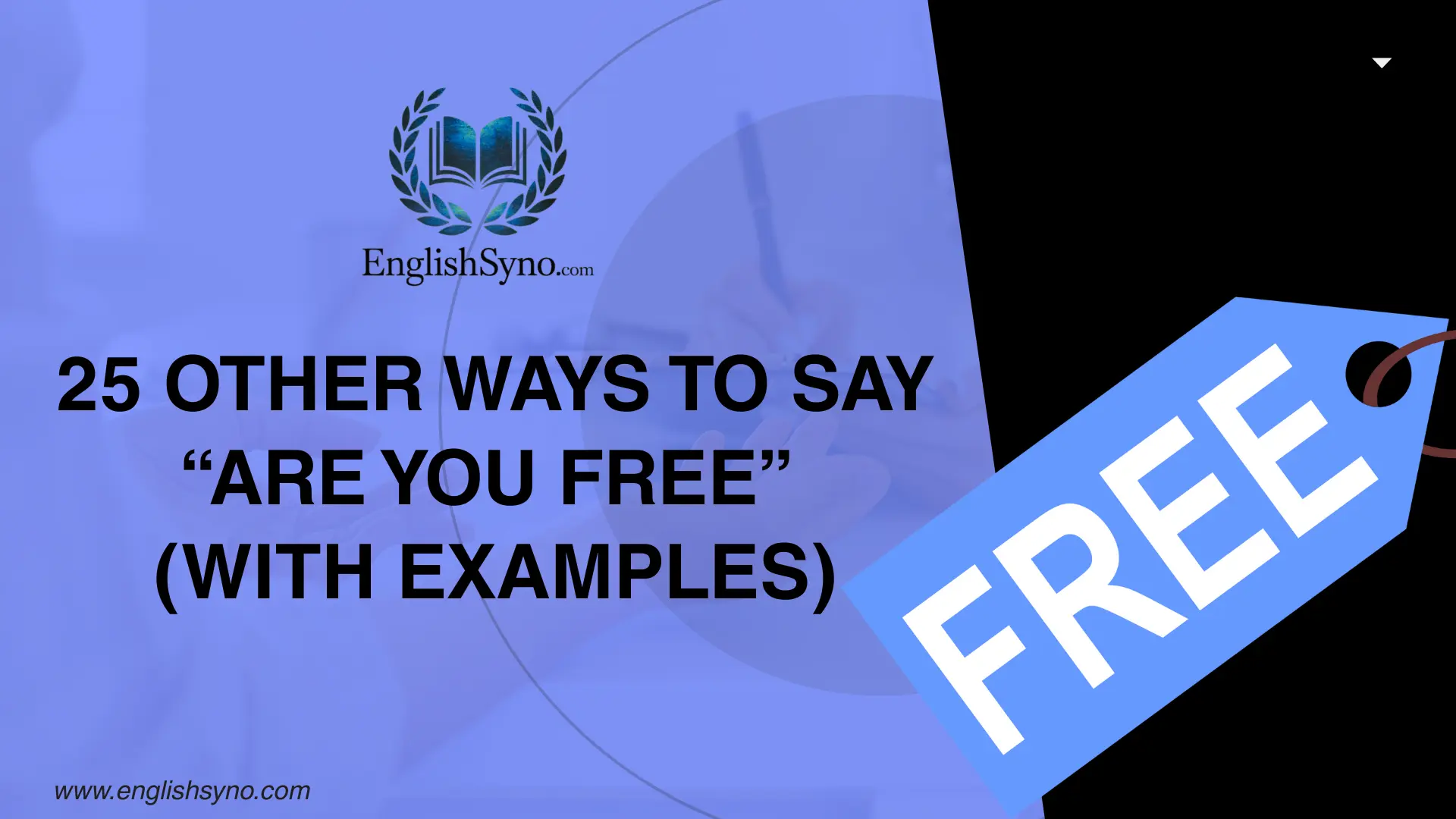When you are trying to ask someone if they are free, it’s important to know the right way to communicate. Are You Free is a simple phrase, but in a professional environment, using it without making the phrase feel too casual or unclear is key to effective communication. You might have a favor to do, get together, talk, or check if someone is available. Choosing the right channel, like emails, instant messaging, or texts, makes the interaction well-suited for the workplace.
This article lists ten alternatives and examples of how to ask someone if they are free without being informal. We’ll explore each option, offering varied, polite ways for different situations, atmospheres, or relationships with coworkers. Some tips on when to use these phrases include checking if the collegial relationship is familiar, if meetings are less formal, or if communicating through channels is appropriate. Although it’s considered more informal than other ways, this approach can help maintain polite and effective communication.
What Does “Are You Free” Mean?
Are You Free is a phrase used to ask if someone has time to talk, meet, or engage in an activity. It implies checking availability while maintaining a respectful tone. The phrase can be formal or informal, depending on the context and the relationship with the recipient.
When to Use “Are You Free”
Use Are You Free when you want to reach out to someone without assuming their availability. It’s perfect for scheduling meetings, checking in with coworkers, or asking a favor in a friendly and respectful way.
Is It Professional/Polite to Say “Are You Free”?
Yes, it can be professional if phrased carefully. In a workplace environment, pairing Are You Free with contextual information, like a reason for the meeting or task, ensures clarity and politeness.
Pros or Cons
Pros: Simple, direct, versatile, polite if used correctly.
Cons: Can feel informal in strict professional settings or unclear if no context is given.
Do You Have a Moment?
Meaning & Explanation: This alternative asks politely for someone’s time without implying urgency.
Example: “Do you have a moment to discuss the report?”
Best Use: Quick conversations or clarifying details.
Worst Use: Urgent meetings where immediate attention is required.
Tone: Polite, approachable.
Are You Available?
Meaning & Explanation: Directly checks availability for a task or meeting.
Example: “Are you available to review the project draft today?”
Best Use: Scheduling professional meetings.
Worst Use: Casual check-ins among close friends.
Tone: Neutral, professional.
Can We Talk?
Meaning & Explanation: Indicates you want to converse without specifying duration.
Example: “Can we talk about the new proposal?”
Best Use: Informal workplace chats or urgent discussions.
Worst Use: Overly formal emails without context.
Tone: Direct, slightly casual.
Do You Have Time to Chat?
Meaning & Explanation: Friendly and respectful way to check availability.
Example: “Do you have time to chat about the presentation slides?”
Best Use: Colleagues or team members in informal settings.
Worst Use: Very formal executive meetings.
Tone: Casual, courteous.
Is This a Good Time?
Meaning & Explanation: Ensures timing is convenient for the recipient.
Example: “Is this a good time to review your feedback?”
Best Use: Interrupting someone politely.
Worst Use: When the matter is urgent and cannot wait.
Tone: Respectful, considerate.
When Can We Talk?
Meaning & Explanation: Politely asks for a specific time to converse while respecting the recipient’s schedule.
Example: “When can we talk about the upcoming client meeting?”
Best Use: Scheduling discussions in professional or friendly settings.
Worst Use: Abrupt requests without considering urgency.
Tone: Polite, considerate.
Are You Open for a Quick Chat?
Meaning & Explanation: A friendly way to check willingness and availability without imposing.
Example: “Are you open for a quick chat about the report?”
Best Use: Informal professional conversations.
Worst Use: Formal emails or highly structured meetings.
Tone: Casual, approachable.
Do You Have a Few Minutes?
Meaning & Explanation: Requests a short block of time to discuss something important.
Example: “Do you have a few minutes to go over the agenda?”
Best Use: Quick clarifications or updates.
Worst Use: Long discussions or detailed meetings.
Tone: Polite, concise.
Can I Grab You for a Moment?
Meaning & Explanation: Informal phrase to engage someone briefly, usually in person or via chat.
Example: “Can I grab you for a moment to check the figures?”
Best Use: Casual, in-person interactions.
Worst Use: Formal email or distant professional relationships.
Tone: Friendly, informal.
Would You Have Time to Meet?
Meaning & Explanation: A Formal way to request a meeting politely.
Example: “Would you have time to meet regarding the project plan?”
Best Use: Scheduling professional meetings with colleagues or superiors.
Worst Use: Casual or instant messaging for informal chats.
Tone: Polite, professional.
Is Now a Good Time?
Meaning & Explanation: Checks current availability for a conversation or task.
Example: “Is now a good time to review the presentation?”
Best Use: Immediate discussions without being intrusive.
Worst Use: Matters that can be scheduled ahead.
Tone: Respectful, considerate.
Do You Have a Moment to Discuss?
Meaning & Explanation: Requests a short discussion politely, usually with context.
Example: “Do you have a moment to discuss the quarterly report?”
Best Use: Quick professional conversations.
Worst Use: Very informal interactions or casual texts.
Tone: Polite, professional.
Can I Steal You for a Minute?
Meaning & Explanation: Informal, friendly way to get someone’s attention briefly.
Example: “Can I steal you for a minute to clarify the numbers?”
Best Use: Colleagues you know well.
Worst Use: Senior executives or formal settings.
Tone: Casual, friendly.
Are You Around?
Meaning & Explanation: Checks physical or virtual presence in a casual tone.
Example: “Are you around to review the slides?”
Best Use: Casual, quick checks.
Worst Use: Formal emails or scheduled meetings.
Tone: Informal, approachable.
Do You Have a Sec?
Meaning & Explanation: Extremely short, casual request for someone’s time.
Example: “Do you have a sec to talk about the budget?”
Best Use: Quick chats among familiar coworkers.
Worst Use: Professional emails or formal communication.
Tone: Casual, friendly.
Are You Free to Catch Up?
Meaning & Explanation: Casual invitation to talk or reconnect.
Example: “Are you free to catch up over coffee this afternoon?”
Best Use: Friendly professional interactions or team bonding.
Worst Use: Urgent business discussions.
Tone: Friendly, approachable.
Can We Schedule a Time?
Meaning & Explanation: Formal way to request a planned meeting.
Example: “Can we schedule a time to discuss the new project?”
Best Use: Professional settings requiring coordination.
Worst Use: Informal chats among teammates.
Tone: Professional, neutral.
Are You Good to Talk?
Meaning & Explanation: Casual, polite check for readiness to converse.
Example: “Are you good to talk about the update?”
Best Use: Informal office interactions.
Worst Use: Formal emails or client communications.
Tone: Casual, friendly.
Is This a Convenient Time?
Meaning & Explanation: Polite way to ensure the recipient is comfortable discussing matters now.
Example: “Is this a convenient time to review the proposal?”
Best Use: Professional or client communications.
Worst Use: Casual team chats where urgency is implied.
Tone: Respectful, professional.
Could You Spare a Few Minutes?
Meaning & Explanation: Requests time politely without being pushy.
Example: “Could you spare a few minutes to discuss last week’s updates?”
Best Use: Professional meetings or email requests.
Worst Use: Quick, informal conversations.
Tone: Polite, professional.
Are You Up for a Quick Discussion?
Meaning & Explanation: Friendly invitation to talk briefly, often for informal updates.
Example: “Are you up for a quick discussion about the client feedback?”
Best Use: Team meetings or collaborative work.
Worst Use: Formal board meetings.
Tone: Casual, approachable.
Do You Have Availability?
Meaning & Explanation: A Formal, professional check of someone’s schedule or free time.
Example: “Do you have availability this afternoon to meet?”
Best Use: Scheduling with clients or higher management.
Worst Use: Casual chats or friendly catch-ups.
Tone: Professional, neutral.
Can We Connect?
Meaning & Explanation: Broad, friendly request to initiate conversation or meeting.
Example: “Can we connect regarding the project timeline?”
Best Use: Professional or networking contexts.
Worst Use: Casual instant messaging with familiar coworkers.
Tone: Professional, friendly.
Are You Around for a Quick Chat?
Meaning & Explanation: Checks if someone is present and available for a brief talk.
Example: “Are you around for a quick chat about the deliverables?”
Best Use: Informal office interactions.
Worst Use: Formal meeting requests or client communication.
Tone: Casual, approachable.
Would You Be Free Later?
Meaning & Explanation: Polite inquiry about future availability rather than immediate.
Example: “Would you be free later to discuss the final draft?”
Best Use: Scheduling conversations later in the day.
Worst Use: Immediate urgent discussions.
Tone: Polite, flexible.
Final Thoughts
Finding the right way to ask “Are You Free” is more than just a simple check on someone’s availability-it’s a chance to show respect, consideration, and empathy for the other person’s time. By using thoughtful alternatives, you can tailor your approach to different contexts, whether professional, casual, or semi-formal. Each variation offers a unique tone that can make your communication feel warmer, politer, and more personal.
Understanding the best use and worst use of each phrase ensures your message is appropriate and well-received. For instance, asking “Do you have a moment?” might suit quick informal chats, while “Would you have time to meet?” works better for scheduled professional meetings. Using the wrong phrasing can lead to misunderstandings, appearing either too casual or overly formal.
In today’s busy world, showing thoughtfulness in small ways like this can strengthen relationships, improve collaboration, and make everyday interactions smoother. Remember, communication is not just about getting a yes or no; it’s about building rapport, respecting boundaries, and being attentive to the recipient’s comfort and availability. With these 25 alternatives, you now have a toolkit to communicate effectively, politely, and empathetically, helping your messages resonate whether you’re talking to colleagues, friends, or clients. Thoughtful phrasing is a small gesture that leaves a lasting impression.
Frequently Asked Questions (FAQs)
What does “Are You Free” mean?
It’s a phrase used to politely check someone’s availability for talking, meeting, or completing a task. It shows respect for the person’s time.
Is “Are You Free” professional?
Yes, when used with context and courtesy. Pair it with reasons for discussion to maintain a professional and polite tone.
When should I use “Are You Free”?
Use it when you want to schedule a meeting, ask for a favor, or start a conversation, either casually or professionally.
Can it be used with clients?
Yes, if phrased politely, e.g., “Are you free to discuss the project later?” It works well in professional emails or calls.
What’s the best alternative to “Are You Free”?
Options like “Do you have a moment?” or “Would you have time to meet?” are professional and respectful alternatives.
Can it be used in instant messaging?
Absolutely. Phrases like “Are you around?” or “Do you have a sec?” are suitable for texts or chat apps.
How casual is this phrase?
It depends on the context. In professional emails, it can be formal; in texts or chats, it’s casual.
What tone should I use?
Use polite, respectful, and considerate tone, matching the relationship and context with the recipient.
Is it okay for quick favors?
Yes. Short phrases like “Do you have a moment?” are perfect for asking a small favor or help.
How to make it more personal?
Add context or reason for asking, e.g., “Are you free to discuss your ideas on the report?” It feels thoughtful and warm.
Can it sound rude?
If asked abruptly or without context, it might appear demanding or intrusive. Always pair with politeness.
Are there time-specific alternatives?
Yes. Use “Would you be free later?” or “When can we talk?” to check availability at a convenient time.
How to use it for remote teams?
Use chat or emails, e.g., “Do you have time to chat today?” It works well for virtual collaboration.
What are common mistakes?
Being too casual in formal contexts or too vague without giving a reason can confuse the recipient.
Why is phrasing important?
It sets the tone, shows respect, and ensures your request is well-received, improving communication and collaboration.



